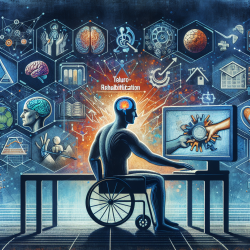Tele-neurorehabilitation holds immense potential for enhancing patient outcomes by overcoming traditional barriers to accessibility. However, the adoption of this model has been slow, largely due to uncertainties about its feasibility and acceptability. A recent study titled "Using the Technology Acceptance Model to Identify Factors That Predict Likelihood to Adopt Tele-Neurorehabilitation" provides valuable insights into this issue. This blog explores how practitioners can implement these findings to improve their skills and encourage further research.
Understanding the Technology Acceptance Model (TAM)
The Technology Acceptance Model (TAM) has been widely used to predict an individual's likelihood to adopt and use new technology. The TAM3, an advanced version of the original model, incorporates elements like computer self-efficacy and computer anxiety. These factors significantly influence the adoption of tele-neurorehabilitation among both stroke survivors and clinicians.
Key Findings from the Study
The study identified several factors that impact the adoption of tele-neurorehabilitation:
- Computer Self-Efficacy: Confidence in one's ability to use technology is a strong predictor of adoption.
- Computer Anxiety: Fear or apprehension about using technology can hinder adoption.
- Perceived Usefulness: The belief that tele-neurorehabilitation will be beneficial influences its acceptance.
- Perceived Ease of Use: Systems that are user-friendly and easy to navigate are more likely to be adopted.
Practical Steps for Practitioners
Based on these findings, practitioners can take several steps to improve their skills and encourage the adoption of tele-neurorehabilitation:
- Enhance Training: Provide comprehensive training sessions to improve computer self-efficacy among both patients and clinicians.
- Reduce Anxiety: Simplify the technology and offer continuous support to reduce computer anxiety.
- Highlight Benefits: Clearly communicate the benefits of tele-neurorehabilitation to both patients and their families.
- Focus on User Experience: Choose user-friendly systems and solicit feedback to continually improve the experience.
Encouraging Further Research
While the study provides valuable insights, there are still gaps that need to be addressed. Practitioners are encouraged to conduct further research on:
- The impact of cognitive impairments on the adoption of tele-neurorehabilitation.
- The amount and type of training required to establish computer self-efficacy.
- Long-term outcomes of tele-neurorehabilitation compared to traditional methods.
By implementing these findings and encouraging further research, practitioners can help shift tele-neurorehabilitation from a research concept to a mainstream healthcare solution.
To read the original research paper, please follow this link: Using the Technology Acceptance Model to Identify Factors That Predict Likelihood to Adopt Tele-Neurorehabilitation.










